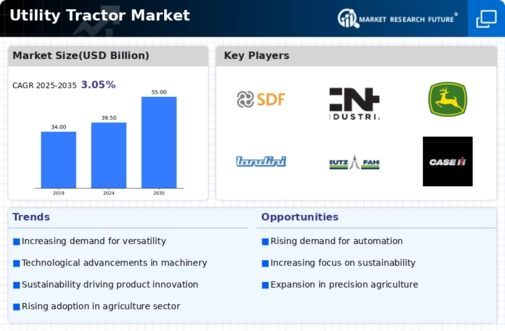Market Growth Projections
The Global Utility Tractor Market Industry is projected to experience substantial growth in the coming years. With a market value anticipated to reach 39.5 USD Billion in 2024 and further increase to 55 USD Billion by 2035, the industry is on a promising trajectory. The compound annual growth rate of 3.05% from 2025 to 2035 underscores the sustained demand for utility tractors as agricultural practices evolve. This growth is indicative of the broader trends in mechanization and technological advancements within the agricultural sector, highlighting the essential role of utility tractors in modern farming.
Expansion of Agricultural Land
The expansion of agricultural land globally is a significant driver of the Global Utility Tractor Market Industry. As populations grow and urban areas expand, there is a pressing need to increase food production. This demand leads to the cultivation of previously unused or underutilized land, necessitating the use of utility tractors for efficient farming. The market is poised for growth as more farmers invest in tractors to maximize productivity on larger tracts of land. This trend is expected to contribute to the overall market value, reinforcing the importance of utility tractors in meeting global food security challenges.
Rising Agricultural Mechanization
The Global Utility Tractor Market Industry experiences a notable surge due to the increasing mechanization in agriculture. Farmers are progressively adopting tractors to enhance productivity and efficiency in crop production. This trend is particularly evident in developing regions, where traditional farming practices are being replaced by modern techniques. The demand for utility tractors is expected to contribute to the market's growth, projected to reach 39.5 USD Billion in 2024. As agricultural practices evolve, the reliance on utility tractors for tasks such as plowing, planting, and harvesting becomes more pronounced, indicating a shift towards mechanized farming.
Government Initiatives and Subsidies
Government initiatives aimed at promoting agricultural productivity play a pivotal role in the Global Utility Tractor Market Industry. Various countries implement subsidy programs to encourage farmers to invest in modern machinery, including utility tractors. These initiatives not only alleviate the financial burden on farmers but also stimulate market growth. For instance, several governments have introduced financial assistance schemes that facilitate the purchase of tractors, thereby driving demand. As a result, the market is likely to witness a steady growth trajectory, with projections indicating a market size of 55 USD Billion by 2035, reflecting the positive impact of such policies.
Technological Advancements in Tractors
Technological innovations are transforming the Global Utility Tractor Market Industry, enhancing the functionality and efficiency of tractors. Features such as GPS guidance, precision farming tools, and automated systems are becoming increasingly prevalent. These advancements not only improve operational efficiency but also reduce labor costs for farmers. As utility tractors become more sophisticated, their appeal to a broader range of agricultural operations grows. This trend is expected to support a compound annual growth rate of 3.05% from 2025 to 2035, as farmers seek to leverage technology to optimize their agricultural practices and increase yields.
Growing Demand for Sustainable Farming Practices
The Global Utility Tractor Market Industry is witnessing a shift towards sustainable farming practices, driven by environmental concerns and consumer preferences. Farmers are increasingly adopting eco-friendly methods, which often require specialized equipment, including utility tractors designed for sustainable operations. This trend is reflected in the rising demand for tractors that utilize alternative fuels or incorporate energy-efficient technologies. As sustainability becomes a priority in agriculture, the market for utility tractors is likely to expand, aligning with global efforts to reduce carbon footprints and promote environmentally responsible farming.























Leave a Comment